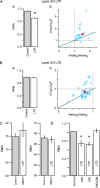Input specificity and dependence of spike timing-dependent plasticity on preceding postsynaptic activity at unitary connections between neocortical layer 2/3 pyramidal cells
- PMID: 19193711
- PMCID: PMC2742592
- DOI: 10.1093/cercor/bhn247
Input specificity and dependence of spike timing-dependent plasticity on preceding postsynaptic activity at unitary connections between neocortical layer 2/3 pyramidal cells
Abstract
Layer 2/3 (L2/3) pyramidal cells receive excitatory afferent input both from neighbouring pyramidal cells and from cortical and subcortical regions. The efficacy of these excitatory synaptic inputs is modulated by spike timing-dependent plasticity (STDP). Here we report that synaptic connections between L2/3 pyramidal cell pairs are located proximal to the soma, at sites overlapping those of excitatory inputs from other cortical layers. Nevertheless, STDP at L2/3 pyramidal to pyramidal cell connections showed fundamental differences from known STDP rules at these neighbouring contacts. Coincident low-frequency pre- and postsynaptic activation evoked only LTD, independent of the order of the pre- and postsynaptic cell firing. This symmetric anti-Hebbian STDP switched to a typical Hebbian learning rule if a postsynaptic action potential train occurred prior to the presynaptic stimulation. Receptor dependence of LTD and LTP induction and their pre- or postsynaptic loci also differed from those at other L2/3 pyramidal cell excitatory inputs. Overall, we demonstrate a novel means to switch between STDP rules dependent on the history of postsynaptic activity. We also highlight differences in STDP at excitatory synapses onto L2/3 pyramidal cells which allow for input specific modulation of synaptic gain.
Figures






References
-
- Aizenman CD, Manis PB, Linden DJ. Polarity of long-term synaptic gain change is related to postsynaptic spike firing at a cerebellar inhibitory synapse. Neuron. 1998;21:827–835. - PubMed
-
- Bi G-Q, Poo M-M. Synaptic modification by correlated activity: Hebb's postulate revisited. Annu Rev Neurosci. 2001;24:139–166. - PubMed

